Non-lethal combat against elephants
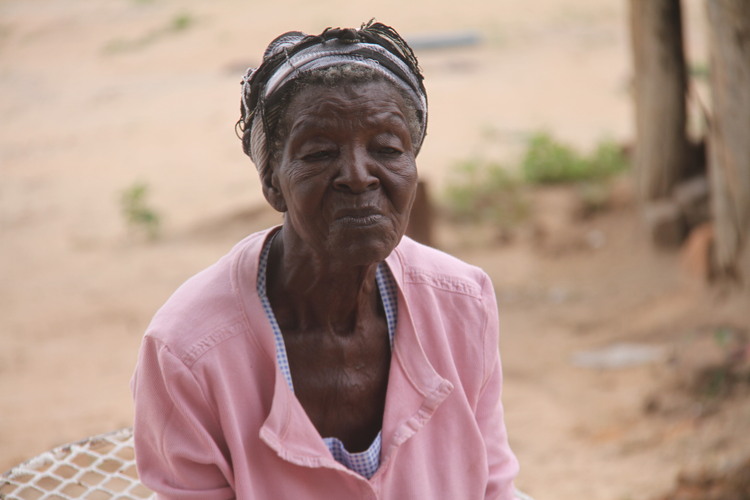
 Sydney Kawadza Senior Features Writer —
Sydney Kawadza Senior Features Writer —
For Ugogo Mallet Moyo of Mpilo Village in Ward 7, Tsholotsho District in Matabeleland North, July 2007 is a year her life turned upside down. That fateful month, forever etched in the 83-year-old’s mind, turned her life into misery.
She was attacked by an elephant, leaving her for dead. Ironically, the octogenarian was coming from receiving her portion of elephant meat.
Rangers had killed an elephant as part of problem animal control (PAC) measures against stray animals from the Hwange National Park. Ten years later, Ugogo Moyo still bears the scars from the attack.
She also needs corrective surgery for the wounds.
“I do not remember the date or day that well. I, however, recall that my colleagues and I were attacked by the elephant.
“The moment I tried to flee the elephant was already on me ripping my stomach open.”
She recalls collecting her intestines which were strewn all over.
“I crawled around gathering my insides putting them on my lap before calling for help,” she recounted.
Ultimately, help arrived, and Ugogo Moyo was taken to Tsholotsho District Hospital and subsequently to Mpilo General Hospital for treatment. While Ugogo Moyo survived the attack, the same cannot be said of 14-year-old Fezile Moyo.
The young boy met his demise while herding cattle in Gulalikabili Village in 2015.
Village head Patrick Nyathi said Fezile and his friends were taking their cattle to a water point when they were attacked.
“It seems the animal was agitated somehow because it chased the boys for some distance until Fezile fell down and was trampled to death,” Mr Nyathi said.
Earlier that year, Timothy Sibanda, who was part of a group of villagers clearing a canal from the Gariya Dam into the village, was also killed by an elephant.
The incidents are part of statistics compiled across Zimbabwe where 96 people have been killed by elephants while hundreds have been injured. In the southern parts of Tsholotsho, the area bordering the Hwange National Park, cases of human-animal conflict have been a cause of concern for villagers.
There are about 450 to 500 elephants living just outside the park in the Pelandaba area. The elephants stray into nearby villages causing damage to crops, attacking people while looking for food and water.
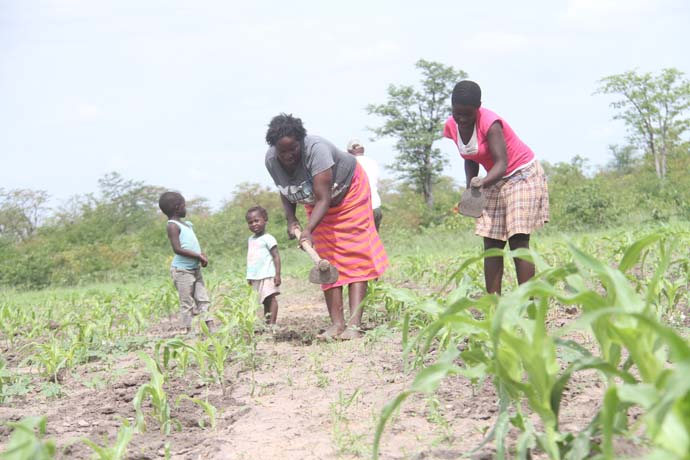
Mrs Sikangizele Ncube and her niece weed their crops in anticipation of improved yields after the successfull implementation of the ChilliGun initiative
According to the CAMPFIRE Association, Hwange National Park, the largest national park in Zimbabwe, has more than thrice its carrying capacity in terms of the elephant population.
The park currently carries more than 45 000 elephants compared to its 15 000 carrying capacity.
“The elephants move in and out of the park in search of food and water… (resulting,) in serious conflict with rural communities in districts bordering Hwange National Park…
“Crop destruction, especially by elephants, can reduce crop yields by up to 18 percent and this is negatively affecting food and nutrition security, (and) is increasing poverty in these areas.”
CAMPFIRE Association director, Mr Charles Jonga said livestock attacks have also reduced herds and are affecting personal incomes.
“There are sporadic disturbances of school attendance when straying wild animals are reported.
“Water sources get contaminated and equipment barely survives, especially when elephants are on the prowl,” he said.
The CAMPFIRE Association has since launched a human and wildlife conflict mitigation project with funding from the Global Environment Facility and the World Bank, in collaboration with the World Wide Fund Zimbabwe.
The pilot project is in Ward 7 of Tsholotsho district and seeks to reduce human and wildlife conflict (HWC) incidents, as well as ensure better wildlife management in the buffer zone of Hwange National Park.
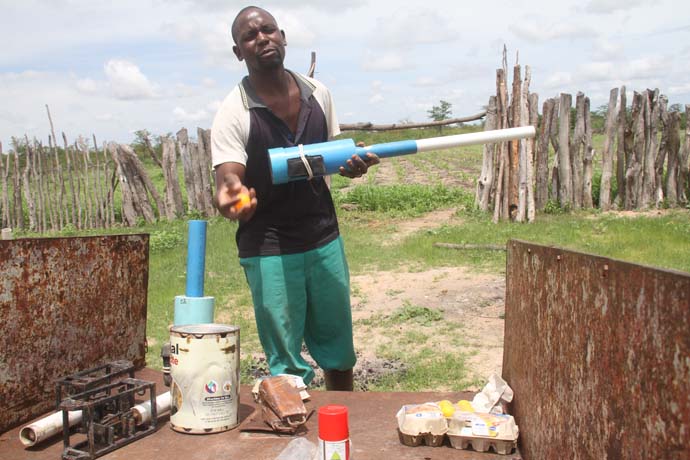
Msiza Dube from Sanxinyama Village demonstrates how the Chilli Gun is used in rebuffing stray elephants from attacking crops
The HWC project is funded under the Hwange Sanyati Biological Corridor Project, whose focus is strengthening the capacity of rural communities in non-lethal human and elephant conflict mitigation and wildlife conservation.
The project uses sustainable and affordable low cost technology – the Chilli Gun (MhiripiriBomba) – and an effective problem elephant pre-warning system.
“Through this project, communities in Tsholotsho are now able to monitor and record HWC incidents and damage.
“The villagers have also been skilled in the use of low cost technology such as the Chilli Gun as a deterrent; and (are now) spending less time guarding crop fields.
“The project offers hope for better harvests by many rural communities, not just in Tsholotsho, but also other parts of Zimbabwe when lessons learned are up-scaled and implemented,” Mr Jonga said.
Mrs Sikangezile Ncube from Saxinyama Village said harvests had been failing because of the elephants.
The Chilli Guns, she said, had brought relief and improved yields to the villagers.
“Before the programme, we faced starvation every year because the elephants destroyed our crops,” she said.
Mrs Ncube has seen her annual yields increase from almost nothing to 21 bags of maize during the 2015 /16 agricultural season.
She grows a variety of crops on her 10-hectare plot including maize, water melons, cowpeas and pumpkins.
“We have had better yields since the introduction of the Chilli Guns and elephants are no longer a threat to the community,” she said.
Sanxinyama deputy village head Mr Master Sibanda said villagers faced a daunting task protecting their crops.
“We never had enough sleep as we repaired damaged fence during the day while keeping vigil during the night,” he said.
The villagers, Mr Sibanda said, also shared their pastures with the elephants.
A number of villagers have undergone training on rebuffing the elephants.
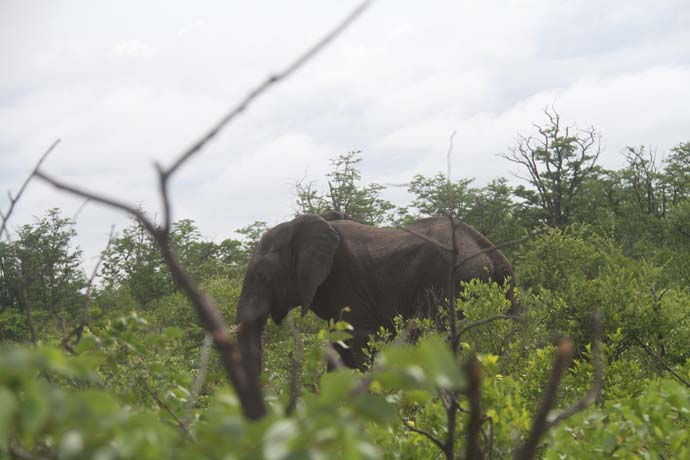
One of the estimated 500 elephants that live just outside Hwange National Park in the Pelandaba Area of Ward 7 in Tsholotsho
One of the Chilli Gun operators, Mr Msiza Sibanda, said the programme was effective.
“The Chilli Guns have been an effective but non-lethal intervention in keeping the balance between wildlife conservation and crop production,” he said.
According to experts, the Chilli bombers process represents a physiological intervention measure rather than a physical one.
It exploits animal behavioural traits, in particular suspicion of anything new, formatting and maintaining a virtual boundary.
The approach consists of, firstly, ambushing all the approach paths using chilli string-enforced ambush “chillibombas” and, secondly, a row of independent single creosoted barriers.
The third stage involves alert fences supporting bells and reflective bottles.
Finally, within the land is the deployment of the Chilli Gun to repel individual elephants that gain access to the protected crops.
Experts’ opinion has shown that during the entire cropping period from December to July 2016, no elephant has penetrated the virtual fence in the villages of Ward 7.
This is despite the fact that an estimated 500 elephant reside within 200 metres of the virtual fence.
“On several occasions, spoor confirmed they approached the barriers but doubled back when they saw or smelt the various interventions placed.
“This was in stark contrast to the previous season where most crops were ravaged,” it was noted.
Before the intervention, 150 cropped lands were completely destroyed, at an estimated loss of $22 000 resulting in the shooting of 14 PAC elephants in the area.
Six of the elephants shot were within the 2km zone of the protected area.
However, after the launch of the programme, only three lands were ravaged, inflicting less than $1 000 damage.
None of these were adjacent to the virtual fence protected area.
No elephants were killed on PAC for the entire ward.
The ward is part of the Hwange Sanyati Biological Corridor spanning about 5,4 million hectares.
Dr Ignatius Musona of the Wild Wildlife Foundation Zimbabwe said most of the HSBC, which has key habitats for wildlife, livestock and people, is too dry for rain-fed crop production.
He said there are high poverty levels and dependency on natural resources for survival by local communities.
Among the challenges affecting the corridor, Dr Musona said, were issues such as wildlife killing and trade with both subsistence and commercial poaching rife.
“The population is growing and there is settlement expansion resulting in competition for space, water and forage resulting in human-wildlife conflicts,” he said.
Dr Musona further noted such challenges as limited economic incentives for local communities, climate change and droughts, forest and land degradation.
The Campfire Association supports rural communities to contribute to the economy through wise and sustainable use of their natural resources.
Communities are assisted in appreciating the profitability of agriculture, cattle ranching and wildlife ranching (mixed land use).
The association also helps local communities manage their land and wildlife for future generations.
Zimbabwe, according to the Parks and Wildlife Management Authority, has an elephant population of more than 83 000.
The population is the second largest in Africa, with the biggest population in north-west Matabeleland.
Feedback: [email protected]



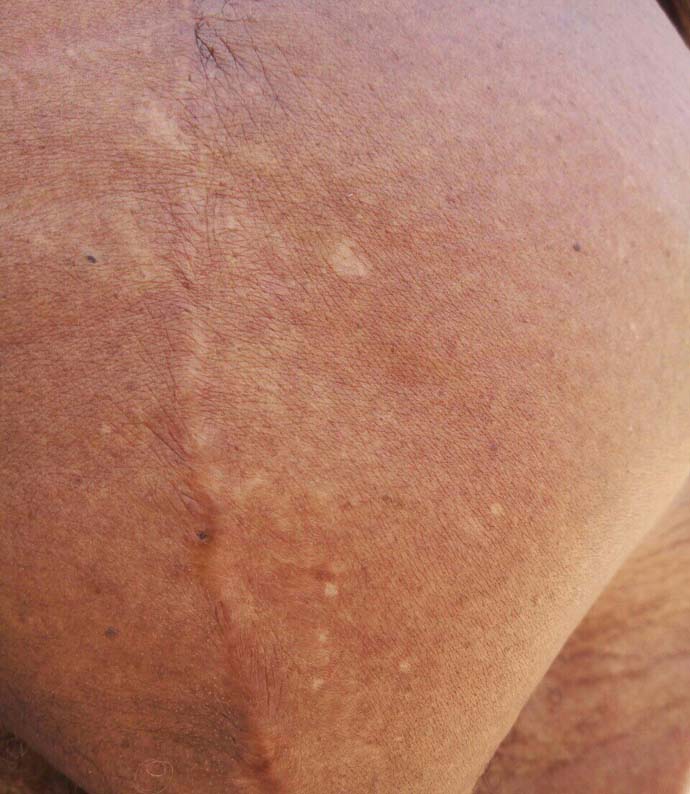






Comments